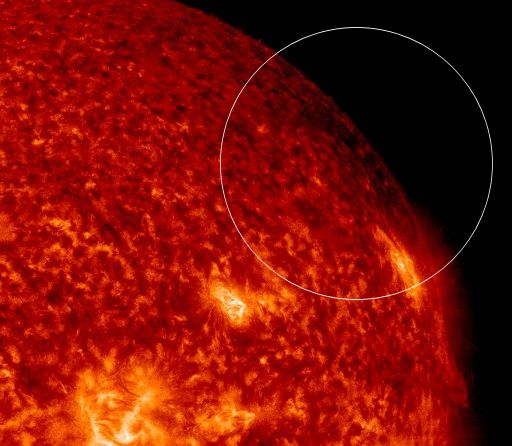When is the best time to see auroras? Where is the best place to go? And how do you photograph them? These questions and more are answered in a new book, Northern Lights - a Guide, by Pal Brekke & Fredrik Broms. | | | CHANCE OF FLARES: Sunspot AR2002 has been mostly quiet for the past 24 hours. Nevertheless, the Earth-facing active region has a'beta-gamma-delta' magnetic field tthat harbors ebergy for strong eruptions. NOAA forecasters estimate a 75% chance of M-class flares and a 15% chance of X-class flares on March 12th. Solar flare alerts: text, voice BLACKOUT! This morning at 06:23 UT, NASA's Solar Dynamics Observatory (SDO) observed a sudden darkening of the sun's northwestern limb. A moment later the whole sun was gone. Scroll past the image to find out what happened: 
Earth itself passed directly in front of the spacecraft, eclipsing the sun. This is SDO's spring eclipse season. Twice every year, around the time of the equinoxes, Earth can pass directly between the Sun and NASA's Solar Dynamics Observatory. At the moment, SDO is near the midpoint of the season when the eclipses are longest and deepest. Once a day, Earth blocks the complete sun for more than an hour. That still allows almost 23 hours for monitoring solar activity, so not much action is missed. Eclipse season ends about a week from now. Between now and then, stay tuned for some rare blackouts. Solar flare alerts: text, voice Realtime Space Weather Photo Gallery FRIDAY IS PI DAY: Mark your calendar. This Friday, March 14th (3.14), is  day. It's an occasion to celebrate one of the most compelling and mysterious constants of Nature. Pi appears in equations describing the orbits of planets, the colors of auroras, the structure of DNA. The value of day. It's an occasion to celebrate one of the most compelling and mysterious constants of Nature. Pi appears in equations describing the orbits of planets, the colors of auroras, the structure of DNA. The value of  is woven into the fabric of life, the universe and ... everything. is woven into the fabric of life, the universe and ... everything. Humans have struggled to calculate  for thousands of years. Divide the circumference of a circle by its diameter; the ratio is for thousands of years. Divide the circumference of a circle by its diameter; the ratio is  . Sounds simple, but the devil is in the digits. While the value of . Sounds simple, but the devil is in the digits. While the value of  is finite (a smidgen more than 3), the decimal number is infinitely long: is finite (a smidgen more than 3), the decimal number is infinitely long: 3.1415926535897932384626433832795
02884197169399375105820974944592307
81640628620899862803482534211706...more Supercomputers have succeeded in calculating more than 2700 billion digits and they're still crunching. The weirdest way to compute  : throw needles at a table or frozen hot dogs on the floor. Party time! : throw needles at a table or frozen hot dogs on the floor. Party time!
Realtime Aurora Photo Gallery
Realtime Comet Photo Gallery
Every night, a network of NASA all-sky cameras scans the skies above the United States for meteoritic fireballs. Automated software maintained by NASA's Meteoroid Environment Office calculates their orbits, velocity, penetration depth in Earth's atmosphere and many other characteristics. Daily results are presented here on Spaceweather.com. On Mar. 10, 2014, the network reported 3 fireballs.
(3 sporadics) 
In this diagram of the inner solar system, all of the fireball orbits intersect at a single point--Earth. The orbits are color-coded by velocity, from slow (red) to fast (blue). [Larger image] [movies]
Potentially Hazardous Asteroids ( PHAs) are space rocks larger than approximately 100m that can come closer to Earth than 0.05 AU. None of the known PHAs is on a collision course with our planet, although astronomers are finding new ones all the time. On March 12, 2014 there were 1459 potentially hazardous asteroids. Notes: LD means "Lunar Distance." 1 LD = 384,401 km, the distance between Earth and the Moon. 1 LD also equals 0.00256 AU. MAG is the visual magnitude of the asteroid on the date of closest approach. | | The official U.S. government space weather bureau | | | The first place to look for information about sundogs, pillars, rainbows and related phenomena. | | | Researchers call it a "Hubble for the sun." SDO is the most advanced solar observatory ever. | | | 3D views of the sun from NASA's Solar and Terrestrial Relations Observatory | | | Realtime and archival images of the Sun from SOHO. | | | from the NOAA Space Environment Center | | | the underlying science of space weather | | 
